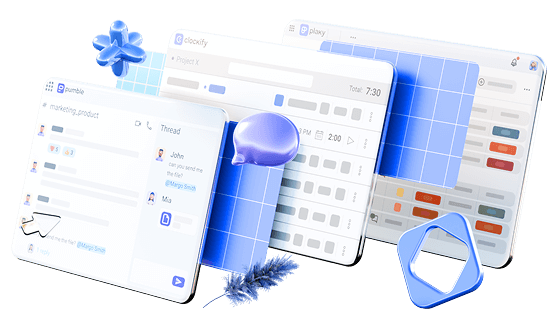How much work can you do efficiently without your laptop? What about your phone — could you survive a mere week without it, knowing you couldn’t have the whole Internet at your fingertips?
It’s a tale as old as time — inventions are presented to us as the “cure-alls” for our ailments. However, as awesome as technology can be, it’s not without its faults.
One of the bigger risks of using technology and AI in the workplace is the role it could play in contributing to burnout — a state of complete and utter exhaustion on a physical, mental, and emotional level.
Now, there are indications that a new type of exhaustion — AI burnout — is slowly infiltrating our lives. But is there a way to prevent it? Here’s what experts say and how they recommend implementing artificial intelligence without triggering burnout.
The rampant burnout crisis
Though the career burnout crisis is slowly dwindling down, the rates remain rather concerning.
According to SHRM’s 2024 research on employee mental health, out of the 1,405 surveyed US employees:
- 51% confessed that they felt used up at the end of the workday,
- 45% said they were emotionally drained from their work, and
- 44% reported feeling burned out at work.
Eagle Hill Consulting’s The State of Worker Burnout 2024 report offers a similar take. Burnout rates have dropped slightly since 2022 when they were at 49%. However, the most recent data from this report shows that nearly half of the US workers (45%) still report feelings of burnout.
Clearly, burnout is a long-standing issue that brings about consequences not just for employees but for their employers as well.
As stated in a study on the correlations between burnout, work-related life quality and mental health, people may experience symptoms that resemble those of depression and anxiety, including:
- Loss of interest,
- Impaired concentration,
- Fatigue,
- Feelings of worthlessness,
- Sleep problems, and more.
But it’s the professional side effects that concern the world of business the most. When your employees are dissatisfied with their jobs, withdrawn, and overall unable to perform well at their jobs, the company’s resources get unnecessarily drained.
Fortunately, years of innovation have allowed technology to become our go-to solution for making our jobs easier and helping us feel less overwhelmed, i.e., burned out.
But — is that really true?
Tech’s role in easing burnout
Former engineering leader at Square Online and Weebly and the Founder & CEO at FutureFund, Darian Shimy, believes technology can play a significant role in easing burnout — as long as we know how to apply it:

“Tools that streamline communication can reduce email overload, while project management software can help teams stay organized without the constant need for check-ins and status updates. Furthermore, technology that supports flexible work arrangements can allow employees to work during hours they find most productive, helping to balance work and personal life more effectively.”
Personal injury lawyer and Co-Founder at Templer & Hirsch, Mark Hirsch, seconds this and explains how his law firm uses tech to make work easier:

“Technology can help prevent burnout by automating tedious chores, improving communication, and balancing work and personal life. Project management software and contact platforms that cut down on email time are examples of tools that make work easier. At Templer & Hirsch, we’ve implemented case management software that keeps track of tasks, which has made our staff much less stressed.”
That said, it’s impossible to ignore how available technology has made us over the last few decades.
Yes, it has boosted our efficiency and made it possible for us to do more in less time. Tech has also helped businesses unlock growth opportunities they could have only dreamed about back in the day.
But at the same time, technology — including AI — is actually contributing to employee stress, and coincidentally, burnout.
How does AI contribute to burnout?
According to a Quantum Workplace survey, employees who often use AI report higher burnout levels (45%) than those who do so infrequently (38%) or never at all (35%).
But how does AI contribute to burnout exactly? A couple of ideas are at play here.
A recent CNBC/SurveyMonkey Workforce Survey highlighted that AI could contribute to burnout by making us anxious about our job security. Indeed, according to the survey, a quarter of US workers (24%) are apprehensive about AI making their jobs obsolete.
Shimy also identifies that AI largely acts as a stressor in the workplace and could make employees feel inadequate:

“Constant monitoring by AI tools can lead to a feeling of being watched and pressure to perform, which can increase stress levels. Furthermore, if AI tools are introduced without proper training or change management, they can lead to frustration and a sense of inadequacy, thereby increasing burnout instead of alleviating it.”
On the other hand, Melanie Franklin, a thought leader in transformational change, author of Neuroscience for Change at Work, and Founder of Capability for Change, shares that one of the ways AI contributes to burnout is through our perception of change:

“AI has the ability to streamline and simplify routine tasks. We can save time by using generative AI tools like ChatGPT to process volumes of information and return summaries and descriptions, so report writing and presentations are quicker to develop. But…all these tools are yet more changes that our brains need to process, which feeds the feeling of burnout.”
So how does a big change, such as the introduction of AI in the workplace, influence us? Franklin explains that it contributes to a rather intense reaction:

“From a neuroscientific perspective, change creates a powerful threat response, generating a cocktail of chemicals that are experienced as stress and anxiety, including adrenaline, epinephrine, and cortisol. [So,] if we want to avoid burnout, we need to put as much effort into minimizing the energy and effort needed for constant change as we do [in] coming up with ideas for more change.”

According to Franklin, one way of doing so is to focus on creating a more positive experience for employees:

“Some of my most impactful work with executives is explaining the need to focus on the achievement of business results and the experience they are creating for employees. If executives fail to create a positive experience, they are shooting themselves in the foot because the next time they want staff to commit effort to adopting new ideas and new ways of working, they will be met with all the symptoms of burnout: cynicism; distrust; withdrawal of discretionary effort.”
Is there a bright side to using AI?
The good news is — the story isn’t over yet.
Every invention comes with a few caveats, and the same goes for AI. But according to our sources, the continuous frustration burnout brings could be alleviated by AI in a few different ways.
Hirsch, for instance, highlights mundane task automation as one of the perks of using AI:

“AI can help people who feel burned out by automating tedious chores, making personalized suggestions, and helping people make better decisions. For example, legal study tools powered by AI can quickly review huge amounts of data, freeing our lawyers to do more meaningful work. This makes you more productive and keeps your mind from repeatedly getting tired from doing the same things.”
Moreover, Shimy believes AI could help managers take a more proactive approach to tackling factors that contribute to burnout:

“AI-driven analytics can also help managers identify patterns that may lead to burnout, such as excessive working hours or uneven workload distributions, enabling proactive adjustments. Additionally, AI-powered wellness apps can provide personalized recommendations for stress management and mental health, tailored to each employee’s behaviors and needs.”
Practical proof of AI’s usefulness already exists. According to recent research on using AI to reduce physician burnout, AI might be able to reduce physician workloads by improving the documentation process. Another study on using ChatGPT for teacher workload relief and burnout prevention showed AI’s potential to improve teaching and learning practices.
Evidently, avoiding AI isn’t the solution — but neither is going in blindly and hoping the negative consequences won’t touch you.
So how do you mitigate burnout without shunning AI completely? As with most things in life, the secret is in — balance.
How to mitigate AI burnout
Now that we’ve actively started to use AI across many industries, AI burnout may become prevalent in the workplace.
But, just like with regular burnout, we could avoid it from the get-go — or at least lessen its effects.
Monitor AI’s impact
As health IT leader and CEO of Riveraxe LLC, David Pumphrey explains, AI alone isn’t going to fix burnout, and when misused, it could actually worsen it. However, monitoring its impact should help mitigate it:

“We carefully monitor how new tools impact employees and make adjustments to avoid potential downsides. The key is using AI to complement human capabilities, not compete with them. With care and oversight, AI and other technologies have the potential to ease burnout, but management and culture are equally important. An organization dedicated to wellbeing considers how every policy and tool impacts employees, making their health a priority.”
Have an open communication within the company about AI
To avoid the harmful effects of AI usage, Shimy recommends leveraging AI tools with strategic planning and careful implementation:

“Training and continuous support are key to ensuring that employees feel comfortable and empowered by these tools, not overwhelmed or replaced by them. To mitigate any potential negative effects, it’s important to maintain an open dialogue about the use of AI in the workplace, actively seeking feedback from employees on their experiences and adjusting strategies as necessary.”
Entrepreneur and co-owner of Nesta Systems, Matt Henderson, agrees, stating that starting small and communicating consistently is the right approach:

“I would recommend leveraging AI carefully and with oversight. Have managers and employees collaborate to pinpoint pain points, then explore AI solutions to address them. Start with small pilots, evaluate the impact, and make adjustments before wide rollout. Most importantly, communicate openly and reassure teams about how AI will — and won’t — impact their roles. With the human touch, AI can be a useful ally against burnout. But humans must remain firmly in the loop.”
Nurture a supportive, human-focused company culture
Meanwhile, Richard Mattingley, mental health expert and Director of Coaching at Share the Struggle, reminds us that just tackling the potential side effects of AI usage isn’t enough to combat burnout:

“Misused, AI could worsen burnout by increasing workload demands or job insecurity. The key is using AI judiciously while prioritizing work-life balance and a transparent organizational culture. I’d recommend AI for repetitive tasks, keeping staff in strategic roles, and building connections. Together, AI and culture can drive progress without the downsides. When approached right, technology and people can thrive.”
Pumphrey agrees, reminding us that humans should remain the focal point when AI is introduced:

“Technology evolves quickly, as do workplace pressures, so burnout will likely remain an ongoing challenge. But by keeping the human touch central, using AI judiciously, and cultivating an open, supportive culture, companies can build sustainable solutions.”
AI can be both a friend and a foe
Evidently, you can have too much of a good thing when it comes to AI. Despite making it easier to tackle everyday work commitments, artificial intelligence could increase the chances of burnout, leaving consequences to both employers and their staff.
That said, shying away from it while your competitors use it to their advantage is not the right decision. Instead, taking on a balanced approach seems to be the answer.
Much like with most things in life, we can provide arguments against and for AI. But it’s the way it impacts humanity that matters most.
With responsible use, AI is more of a friend than a foe and could help us build greater accomplishments in the future. When misused, however, AI is a powerful burnout factor that could make physical and mental exhaustion worse.
So, tread carefully while you explore its potential, and as Pumphrey explains, remember that AI isn’t the ultimate burnout cure:

“The only way to truly address burnout is by empowering employees and giving them the bandwidth to focus on meaningful work. AI is just one part of the solution.”




